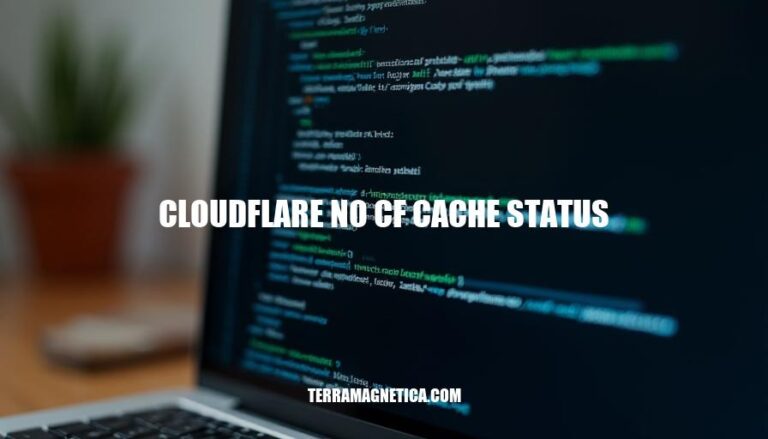


The ‘Cloudflare no cf cache status’ indicates that Cloudflare did not cache the requested resource. This can happen for several reasons, such as the resource being marked as private, having cookies, or the request method not being a GET.
Understanding and optimizing this status is crucial for web performance because caching can significantly reduce load times by serving content from the nearest edge server rather than the origin server. When resources are not cached, it can lead to slower response times and increased server load, negatively impacting user experience and website performance.
Does this help clarify things?
Cloudflare’s caching system stores copies of frequently accessed content, such as images, videos, and webpages, in geographically distributed data centers closer to end users than origin servers. This reduces server load and improves website performance by delivering content more quickly.
The ‘cf-cache-status’ header indicates the cache status of a resource. When ‘cf-cache-status’ is set to ‘no-cache’, it means Cloudflare did not cache the resource due to specific cache-control headers or settings.
This can happen if the resource is marked as private, no-store, or if certain cookies are set.
Open your web browser and navigate to the website you want to check.
Right-click on the webpage and select “Inspect” or press Ctrl+Shift+I (Windows) or Cmd+Option+I (Mac) to open the developer tools.
Go to the “Network” tab in the developer tools panel.
Refresh the webpage to load all network requests.
Click on any network request in the list.
Look for the “cf-cache-status” header in the “Response Headers” section.
If the “cf-cache-status” header is present, it will indicate whether the resource was served from Cloudflare’s cache or not. The possible values are:
HIT: The resource was served from Cloudflare’s cache.
MISS: The resource was not found in Cloudflare’s cache and was fetched from the origin server.
EXPIRED: The resource was previously cached but has now expired.
BYPASS: Cloudflare did not cache the resource due to specific cache settings.
By following these steps, you can determine the cache status of resources on your website.
Cache-Control header settings: Cloudflare does not cache resources when the Cache-Control header is set to private, no-store, no-cache, or max-age=0.
Set-Cookie header: The presence of a Set-Cookie header prevents caching.
Non-GET HTTP methods: Cloudflare does not cache responses for HTTP request methods other than GET.
Origin server response: If the response comes directly from the origin server without any subrequests, Cloudflare will not cache it.
Cache rules: Specific cache rules set in Cloudflare might prevent caching of certain resources.
Expired cache: Cached content might have expired and needs to be refreshed.
DNS issues: Incorrect DNS settings can prevent Cloudflare from detecting and caching content.
Configuration errors: Misconfigurations in Cloudflare settings can lead to caching issues.
Check Cache-Control Headers: Ensure that your server is not sending headers like no-store, no-cache, must-revalidate, or max-age=0. These headers instruct Cloudflare to bypass the cache.
Verify DNS Settings: Confirm that your domain’s DNS settings are correctly pointing to Cloudflare. Incorrect DNS settings can prevent Cloudflare from detecting and caching your content.
Disable Other Caching Plugins: If you’re using other caching plugins or server rules that might be conflicting with Cloudflare, disable or remove them.
Clear Cloudflare Cache: Go to your Cloudflare dashboard and manually clear the cache for your domain.
Check Cloudflare Settings: Ensure that your Cloudflare settings are correctly configured to cache content.
This includes settings like Cache Level and Cache TTL.
Inspect HTTP Headers: Use tools like curl -I to inspect the HTTP headers of your responses and check for the CF-Cache-Status header. This can help you determine if Cloudflare is caching your content.
Update Cloudflare Plugin: If you’re using a Cloudflare plugin, ensure it is up to date. Sometimes, outdated plugins can cause caching issues.
Contact Cloudflare Support: If none of the above solutions work, reach out to Cloudflare support for further assistance.
Enable Browser Cache TTL: Set a longer Time-To-Live (TTL) for browser cache to reduce the frequency of cache misses.
Use Tiered Cache: Enable Tiered Cache to store frequently accessed content in multiple locations for faster delivery.
Custom Cache Rules: Create custom cache rules to control the caching behavior of specific HTTP requests.
Cache by Device Type: Configure caching based on device type to optimize content delivery for different devices.
Cache Everything: Use the “Cache Everything” setting to cache all content, including dynamic content.
Cache by Status Code: Set different TTLs for different status codes to optimize cache retention and freshness.
Respect ETags: Ensure that ETags are respected to avoid unnecessary cache revalidation.
Use Cache Reserve: Utilize Cloudflare’s persistent storage to increase cache times and reduce origin server load.
Disable Cache for Dynamic Content: Ensure that dynamic content is not cached to avoid serving outdated information.
Regularly Purge Cache: Regularly purge the cache to remove outdated content and ensure that users receive the latest version of your site.
By following these best practices, you can avoid the “no cf cache status” issue and ensure optimal caching with Cloudflare.
which can lead to slower response times and increased server load. This can happen due to various reasons such as private resources, cookies, non-GET HTTP methods, or specific cache-control headers.